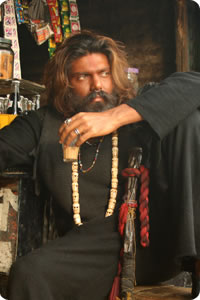to
most of us. It is hard to even imagine that
such a world of misery and despair does
exist very close to us; more than being
hard to imagine, it is hard to believe.
Do such things really happen in the world
around us?
Looking straight into the lives of people
who have to beg for a living, Naan Kadavul
takes what one might call a brutal view
of the existence that they are forced to
lead. What forces them to lead such a miserable
life? One, it is their circumstances and
their helplessness; second, it is a mafia
of sorts being run by a heinous group of
people indulging in human trade. We are
made to feel the pain and distress in their
lives. There are scenes that can make you
squirm in your seats, literally. Now, where
does an Aghori sanyasi from the holy terrains
of Kasi fit into such a plot? It is a lot
like the return of the prodigal son to his
fold after years of alienation. But here
the son who has returned is not repentant
but is foul mouthed, conceited and unapproachable.
But, in spite of all the repulsiveness that
he exudes, there is also an air of mysticism
about him. Largely unconcerned about what
happens around him, he smokes weed, chants
mantras in a different language, does death
defying yoga poses, blows the conch and
does many more things that increase the
mystery about him. But as if by Almighty’s
design, he destroys the evil men. You might
feel that the pace is slack in the first
half, but don’t lose heart, things
pick up considerably in the second.
That
is the story in a nutshell, but there
is more to the movie than just the storyline.
In fact, the story seems to be of secondary
importance to the depiction of unsavory
and disturbing realities. Bala has created
a world of misery where cruel men make
the rules. But, it looks like he was not
sure as to where to draw the line. The
dungeon like setting, the mutilated people
(you see people with all kinds of deformities),
the sharp and crude words used and the
animal like treatment meted out to them
take a toll on the viewer very early in
the movie. It looks like the director
wanted to leave a lump in your throat
but ends up giving you an uneasy stomach.
The movie can be analyzed at length if
necessary, but it is suffice to say that
Bala’s signature shines through
at all places. His attention for detail,
the painstaking picturisation, the raw
and original stunts are all there. And,
even in the midst of such depressing nothingness
he manages to infuse some very natural
and likeable humor, treading a very thin
line. It helps to liven up the atmosphere
a bit. But the end feeling is that he
got too obsessed with depicting the cruelties
inflicted on the beggars by their ‘owners’
which does not help the final product.
Performances!
In a Bala film, you expect the actors
to be at their best. Surprisingly, for
all the hype, Arya does not have that
much of screen time though he does make
an impact whenever he appears. He doesn’t
have much to work with though. He has
always got the same stoic expression,
uttering the same intonations and striking
the same poses. But getting to maintain
that demeanor is not easy and he has worked
hard to do it which can be seen. Pooja
as a blind beggar touches us when she
first appears, but the feeling soon wears
off. Nevertheless, she has maintained
a consistent feeling of pathos putting
in considerable effort into her performance.
The disabled and mutilated people, who
should have been picked straight out of
real life, live their lives on screen.
But the real surprise packet of the film
is the comedian Krishnamoorthy, who has
been previously known only for his capers
with Vadivelu. He turns out a really well
etched performance. All credit to Bala
for spotting the serious actor in him.
Technically
speaking the movie is high on production
values. Be it the townscape of Kasi or
the rustic temple environs or the dark
dungeons, the images have been captured
well. Ilayaraja’s music surprisingly
doesn’t make one sit up and take
notice, mostly because it is gelled neatly
into the narrative. Dialogues by Jayamohan
are few but very crisp and one feels that
he had an influence in the way actors
and an actress of the current generation
are mercilessly bashed about in a scene.
And, if you think that the movie is set
mostly in Kasi then you are wrong, it
is hardly around for 10 minutes.
Bala
has tried to debate a few serious issues
in the movie. The first is obviously about
who is God? He also talks about life and
death and how death is actually a boon
to one who cannot lead a good life. Summing
up, Naan Kadavul is not a movie that everyone
can digest. It shows reality in such brutality
that you wonder whether such things really
do happen. It cannot be called violent;
the word ‘brutal’ has to be
repeated often to describe the movie.
One feels the director could have toned
it down a bit, it leaves one very disturbed.
And, it is hard to believe that the censors
passed this movie with a U/A, it is difficult
to see how children can be expected to
digest such fare which at times borders
on the gory. Even adults would need a
tough mind to endure this movie. It will
make you squirm, cringe, nod and laugh
in alternation. Don’t’ expect
a regular entertainer, be prepared to
get jolted.
Verdict: Brutal depiction of a
world unknown

|



